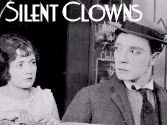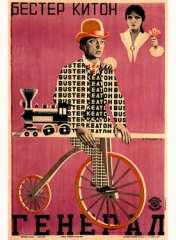THE GENERAL
(1927)With Buster Keaton, Marion Mack, Glen Cavender, Jim Farley, Charles Smith, Frank Barnes
Directed by Buster Keaton and Clyde Bruckman
Silent, Black and White
Reviewed by JB
 Based on a true incident from the Civil War detailed in the book The
Great Locomotive Chase, THE GENERAL is almost universally
recognized as
not only as Buster Keaton's masterpiece but also as one of the
greatest films of all time. Of course the film is a comedy, but
the gags are almost incidental to the story. There's some
very
funny stuff going on as Keaton, as southern engineer Johnny Gray,
chases down his beloved locomotive, the General,
stolen by the Union Army. But most of the sight gags spring
naturally
out of the situation and help further the story along. There
are
almost no jokes just for the sake of jokes in this film, and it should
really be considered an adventure film with comic highlights.
Much of the first half of the film is centered on the Union
train-stealers' attempt to hinder Buster's pursuit (in another
locomotive).
Most of these situations lead to sight gags, but take away
those
gags and the film would be just as exciting to watch. In
other
words, Buster removes the obstacles -planks of wood, uncoupled boxcars
- in funny ways, but he removes them nonetheless and the chase goes on.
Based on a true incident from the Civil War detailed in the book The
Great Locomotive Chase, THE GENERAL is almost universally
recognized as
not only as Buster Keaton's masterpiece but also as one of the
greatest films of all time. Of course the film is a comedy, but
the gags are almost incidental to the story. There's some
very
funny stuff going on as Keaton, as southern engineer Johnny Gray,
chases down his beloved locomotive, the General,
stolen by the Union Army. But most of the sight gags spring
naturally
out of the situation and help further the story along. There
are
almost no jokes just for the sake of jokes in this film, and it should
really be considered an adventure film with comic highlights.
Much of the first half of the film is centered on the Union
train-stealers' attempt to hinder Buster's pursuit (in another
locomotive).
Most of these situations lead to sight gags, but take away
those
gags and the film would be just as exciting to watch. In
other
words, Buster removes the obstacles -planks of wood, uncoupled boxcars
- in funny ways, but he removes them nonetheless and the chase goes on.
Although this could be said bout many of Keaton's films, THE GENERAL holds up remarkably well all these decades later. From the moment Buster sets off to recapture his stolen engine, it is nearly impossible not to get caught up in the chase. In this film, there is no use of back projection or miniatures - what you see is what you get. Keaton truly did risk his life dozens of times over running, jumping, hopping and falling around trains all for the sake of the verisimilitude he desired in all of his films. That was Keaton, not even content with the kinds of hidden safety devices the equally crazy Harold Lloyd used to use in his films.
 A self-described pet project of Keaton's, Keaton said
that for this film, he wanted accuracy "...until it hurts."
While it is a grand epic, often described as a moving Matthew
Brady photograph because of its painstaking recreation of the Civil
War, there is certainly nothing painful in THE
GENERAL outside of a few morbid sight gags concerning the death of
Union and Rebel soldiers. What did hurt was not the attention
to
detail but rather the
failure of THE GENERAL, both with critics and more importantly, the
public. It was obviously an expensive film to make, and
included the mostly costly shot in all of silent movies, the
Union
train
attempting to cross a burning bridge and plummeting into the river when
it collapses. The failure of the film
set Keaton on a downward
career spiral which, along with some bad business decisions, left
him helpless to guide his own future in films. By
the
mid-thirties, while Chaplin was still making silent classics and Harold
Lloyd was doing well with talking comedies of his own, Buster Keaton,
one
of the most brilliant filmmakers and physical comics of the 1920s was
essentially a has-been. It was not until the fifties and
sixties
that
he would once again gain fame, mostly through television work and
revivals of his old movies. At which time, THE GENERAL,
box-office disaster of 1927, was officially hailed as a work of art and
Keaton the king of the silent comedians.
Keaton never complained. He probably even admired
the
circular timing of it all.
A self-described pet project of Keaton's, Keaton said
that for this film, he wanted accuracy "...until it hurts."
While it is a grand epic, often described as a moving Matthew
Brady photograph because of its painstaking recreation of the Civil
War, there is certainly nothing painful in THE
GENERAL outside of a few morbid sight gags concerning the death of
Union and Rebel soldiers. What did hurt was not the attention
to
detail but rather the
failure of THE GENERAL, both with critics and more importantly, the
public. It was obviously an expensive film to make, and
included the mostly costly shot in all of silent movies, the
Union
train
attempting to cross a burning bridge and plummeting into the river when
it collapses. The failure of the film
set Keaton on a downward
career spiral which, along with some bad business decisions, left
him helpless to guide his own future in films. By
the
mid-thirties, while Chaplin was still making silent classics and Harold
Lloyd was doing well with talking comedies of his own, Buster Keaton,
one
of the most brilliant filmmakers and physical comics of the 1920s was
essentially a has-been. It was not until the fifties and
sixties
that
he would once again gain fame, mostly through television work and
revivals of his old movies. At which time, THE GENERAL,
box-office disaster of 1927, was officially hailed as a work of art and
Keaton the king of the silent comedians.
Keaton never complained. He probably even admired
the
circular timing of it all.  ½ - JB
½ - JB
Buster Keaton The Age of Comedy
REMAKES
The Great
Locomotive Chase (1956) - Not a real remake, but a Disney
adventure film based on the same book as The General


